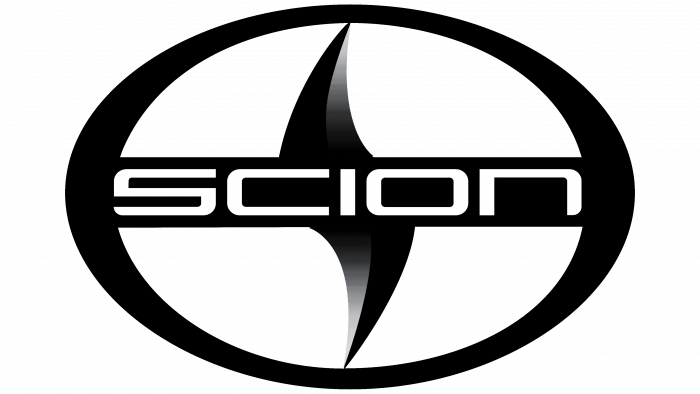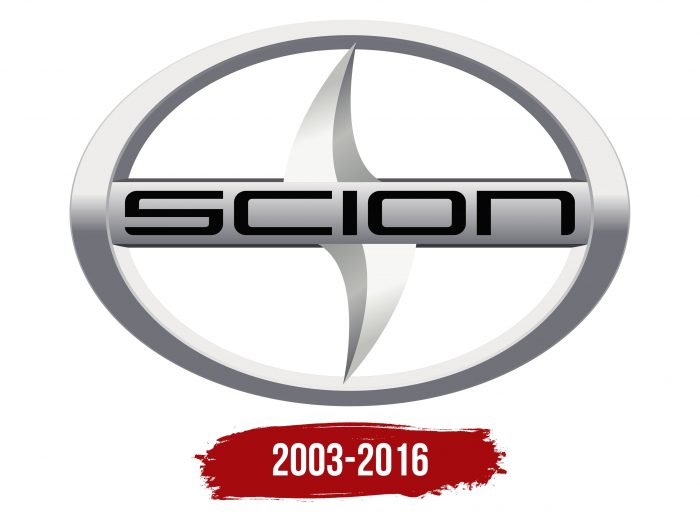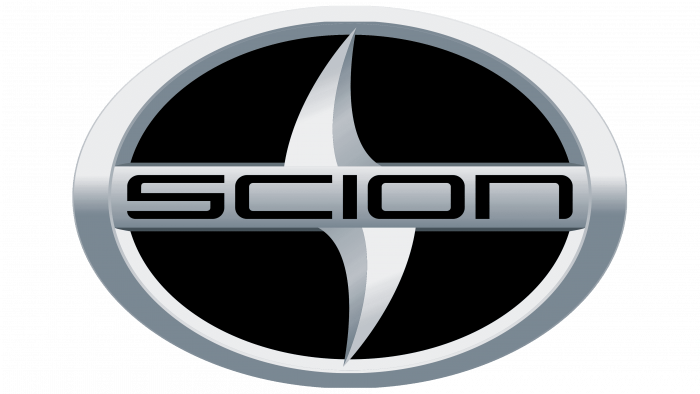The Scion logo promises high performance and endurance. In the sharp lines of the emblem, a stylish, eye-catching body reminiscent of cars of the future, compactness, and the ability to fly along the roads like lightning is encrypted.
Scion: Brand overview
Meaning and History
Scion cars were sold only in the USA and Canada – they did not have time to enter the markets of other countries. Therefore, their logo is not as well-known as that of the same Toyota company. Its central element is the stylized letter “S,” which resembles a Japanese shuriken. The characteristic curved shape and the cold metallic luster are associated with throwing weapons. Moreover, the division into two shades gives the impression of two edges of a sharpened blade.
The designers have placed the first letter of the brand name in the center to emphasize its importance. This word comes from the Old French language: “cion” and “sion” is translated as “twig” or “shoot.” In English, it is used to mean “descendant.” That is, the Scion brand is a descendant of Toyota. And the owners of his cars are millennials, descendants of the previous generation.
What is Scion?
Scion is a former subsidiary of the automotive giant Toyota. The company was founded in 2003. Its headquarters were located in Torrance, California. She produced cars for the youth segment. In 2016, the company was disbanded.
To show the name’s importance, the designers duplicated the full version on a horizontal strip connecting the two sides of the outer ring. Remarkably, the ring is not round but oval—the same as on the Toyota logo. The apparent similarity of the logos speaks of the connection between the parent company and its subsidiary brand.
The ellipse has an uneven thickness: it is narrower at the top and bottom than on the sides. The crossbar does not blend into the ring like the curly elements on the Toyota emblem. It is separated on the right and left by a thin gray stripe. This enhances the 3D effect created with wide paths and linear gradients.
Emblem
The curved “S,” where the brand nameplate is superimposed, has an unusual design. It looks like two dorsal fins of a shark peeking out from under the water. In this case, the symbolism of the emblem becomes even wider than it seems at first glance. The image can indicate high speed, dynamism, and movement. This is a hint that Scion cars are the fastest and most agile. The two sides of the “S” also resemble a road leading to the horizon.
Scion: Interesting Facts
Toyota introduced the Scion in 2002, which aimed to captivate the North American market with a fresh appeal to younger consumers through distinctive vehicle designs and inventive marketing.
- Youth Appeal: Created to attract a younger audience, Scion stood out for design uniqueness and affordability, reflecting Toyota’s ambition to forge a brand synonymous with innovation and appeal beyond traditional models.
- Initial Offerings: Starting with the xB and tC in 2003, Scion made waves with their distinct looks, customization possibilities, and accessibility, resonating well with the intended market segment.
- Straightforward Pricing: Scion adopted a no-haggle pricing policy, simplifying the buying process and catering to consumers seeking a transparent and hassle-free purchase experience.
- Personalization: The brand sets itself apart with extensive customization options, allowing buyers to tailor their vehicles with various accessories, colors, and enhancements, fostering a deeper connection with the brand.
- Pure Price Philosophy: Scion’s “Pure Price” approach ensured transparency in pricing for vehicles, accessories, and services, streamlining the purchase process across dealerships and marketing materials.
- Marketing Innovation: Scion employed nontraditional marketing avenues, including guerrilla tactics, social media, and cultural sponsorships, to cultivate a unique brand identity and engage with its audience on new levels.
- The FR-S: As one of Scion’s final models, the FR-S, known for its rear-wheel drive and praised handling, marked a pivot towards performance-driven offerings, underscoring the brand’s versatility.
- Brand Conclusion: In 2016, Toyota concluded the Scion venture, integrating most models into the Toyota lineup, such as transforming the FR-S into the Toyota 86 in North America, in response to evolving market conditions and brand integration.
- Enduring Influence: Scion’s innovative marketing approach and focus on younger consumers left a significant mark on the industry, cultivating a legacy of memorable vehicles and pioneering sales strategies.
- Worldwide Presence: While Scion was primarily aimed at North American buyers, vehicles like the Scion iQ found a place in global markets under the Toyota marquee, highlighting the international appeal of its vehicle concepts.
From its inception to its integration into Toyota, Scion’s narrative mirrors a dedicated exploration of new markets through youthful branding, vehicle innovation, and a revolutionary approach to sales and marketing, inspiring Toyota’s broader story.
Font and Colors
The creators of the Scion logo did not limit themselves to standard typography – they went beyond the generally accepted boundaries. They came up with their lettering design with thin, elongated sans-serif letters. Later, based on this design, the founder of Type Innovations developed a family of fonts called Scion. He exactly repeated the proportions of the original.
The palette imitates a metallic sheen, so the emblem resembles a sign adorning car radiators. Dark and light shades of gray are combined using contrasting transitions and a smooth gradient. Against their background, a black inscription stands out – the “star” of the logo.
FAQ
How many Scion models are there?
Scion started 2003 as a part of Toyota, targeting young buyers with affordable, stylish cars. The brand existed until 2016 when it launched eight models. These cars were popular for their modern looks, simple choices, and ability to customize.
- xA (2004-2006): This small hatchback was one of the first from the brand. It was fuel-efficient and compact, great for city driving.
- xB (2004-2015): Known for its unique box shape, the xB used space efficiently, making it feel roomier.
- tC (2004-2016): The tC was a sporty coupe loved for its good looks and performance. It was affordable and offered many ways to customize it.
- xD (2008-2014): This car replaced the xA with a bolder look and better performance. It was aimed at those who wanted a dependable and stylish car.
- iQ (2012-2015): Very small and ideal for tight parking spots, the iQ was smartly designed to make the most of its space.
- FR-S (2013-2016): This sports coupe, with its excellent handling and accessibility, was made for driving enthusiasts. It continued as the Toyota 86 after the Scion brand was closed.
- IA (2015-2016): A compact sedan that ventured slightly upscale, known for its smooth ride and well-made interior.
- iM (2015-2016): A hatchback that combined sporty looks with practicality, offering an engaging drive and flexible cargo space.
When production ceased in 2016, Toyota rebranded several models. This has helped streamline Toyota’s offerings and increase its appeal.
Does the Scion brand still exist?
It no longer exists independently. Toyota discontinued the brand in August 2016 to integrate its younger vehicles into its larger lineup. After the brand’s demise, most Scion vehicles were rebadged as Toyota models. For example, the Scion iM became the Toyota Corolla iM, an affordable hatchback. Closing and rebranding its vehicles under the Toyota brand was a move that strengthened the brand and made its vehicles more attractive by associating them with Toyota’s renowned quality and reliability. This made the selection process easier for customers and improved the company’s performance.
What does the Scion logo mean?
The logo is simple but meaningful. It is an oval with a vertical stripe resembling a stylized “S,” the first letter of the Scion name. The stripe resembles a shark’s fin, indicating speed and agility. These qualities appeal to a young and energetic target audience. The shark fin symbolizes moving forward and standing out, corresponding to being distinctive and innovative in the competitive automotive market. This design helped make the brand attractive to younger shoppers looking for something new and different.
Is Scion a Toyota?
Yes, the Scion brand was part of Toyota. The Japanese automaker founded it in 2003 to attract young buyers with affordable and unique cars. In 2016, Toyota discontinued the Scion brand and consolidated most of its models into the Toyota lineup. Models such as the FR-S, iA, and iM, previously sold under the Scion brand, were renamed and continued as Toyota vehicles.
What does Scion the car mean?
The cars were designed with young drivers in mind, emphasizing energy and agility. They were popular for drifting and high-speed driving and valued for their appearance and performance. The name means “successor” or “descendant,” reflecting the idea that these cars represent a new generation of Toyota vehicles.
Why is Scion discontinued?
Production was discontinued because it failed to retain its target audience. It was launched to attract younger buyers with affordable and unique cars, but these consumers preferred the mainstream Toyota brand. This preference change reduced Scion’s unique market appeal.
Management decided to stop brand production and combine its models into the main Toyota lineup. The merger retained the design and essence of the vehicles, allowing their distinctive qualities to remain available but under the Toyota name. This simplified the overall product offering and helped to streamline operations.






